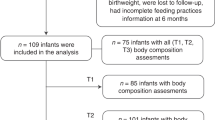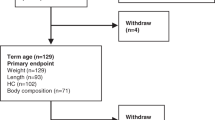Abstract
The maximum and minimum fat intakes that are physiologically tolerable by healthy infants and young children are not well defined. The maximum tolerable fat intake appears to be limited by the minimum requirements of protein, carbohydrates and micronutrients. It is unresolved whether or not there is a minimum metabolic requirement of dietary fat, beyond the requirements of essential fatty acids and lipid soluble vitamins and the effects on energy density and an adequate total energy intake. The first postnatal months of the human infant are characterized by a rapid weight gain and extensive fat deposition. Body fat deposition equals 25% of the total energy intake during the first 2 and 16% during the third and fourth months, respectively. The provision of dietary lipids in amounts at least matching the needs for tissue storage and fat oxidation appears to be of advantage for energy balance and physiological growth. Some reports have associated low fat diets with less than 30% of energy as fat with adverse effects on child growth beyond infancy, but it remains unresolved whether these effects were caused by an associated effect on dietary energy density and total intake of energy and other nutrients. Closely supervised, healthy infants from an affluent population grew normally with a diet providing about 30% of the energy as fat from the seventh month of life onwards, but it is not known to what extent adaptive mechanisms such as a reduction of physical activity may have been required. It is not known whether infants and young children stressed by frequent occurrence of diarrhea and infections may adapt to a 30% fat diet as well or not. No evidence is available for a health benefit of a low total fat intake in infancy. In view of the limited available information, further research is required to define optimal fat intakes in early childhood since this question is of major importance for child health.
This is a preview of subscription content, access via your institution
Access options
Subscribe to this journal
Receive 12 print issues and online access
$259.00 per year
only $21.58 per issue
Buy this article
- Purchase on Springer Link
- Instant access to full article PDF
Prices may be subject to local taxes which are calculated during checkout
Similar content being viewed by others
Author information
Authors and Affiliations
Rights and permissions
About this article
Cite this article
Koletzko, B. Response to and range of acceptable fat intakes in infants and children. Eur J Clin Nutr 53 (Suppl 1), s78–s83 (1999). https://doi.org/10.1038/sj.ejcn.1600746
Published:
Issue Date:
DOI: https://doi.org/10.1038/sj.ejcn.1600746
This article is cited by
-
Thermal properties of fats extracted from powdered baby formulas
Journal of Thermal Analysis and Calorimetry (2012)
-
PUFA and LC-PUFA intake during the first year of life: can dietary practice achieve a guideline diet?
European Journal of Clinical Nutrition (2010)
-
Übergewicht und Adipositas im Kindes- und Jugendalter
Monatsschrift Kinderheilkunde (2007)



